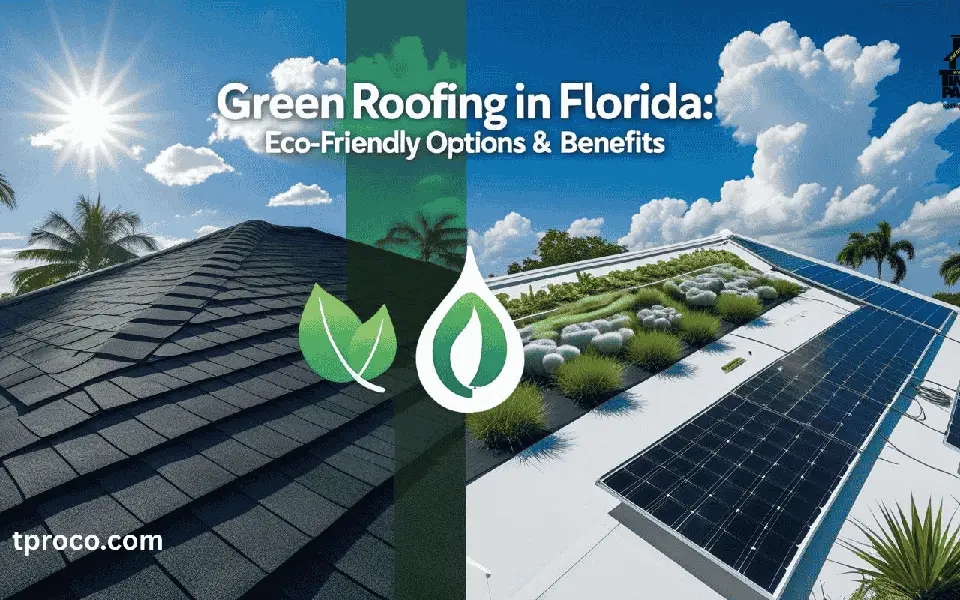Our Blogs
How To Stop Your Roof Leaking in Heavy Rain: Simple Ways
Dealing with a roof leak during heavy rain can be a homeowner's nightmare. Leaks not only cause immediate inconvenience but, if left unchecked, can lead to significant damage and costly repairs. Addressing roof leaks promptly is crucial for maintaining the integrity of your home and preventing issues such as mold growth and structural damage.
In this article, you'll discover:
- Simple solutions for stopping leaks.
- Temporary fixes you can try.
- When to seek professional help.
By understanding these strategies, you'll be well-equipped to manage roofing leaks and protect your home from future damage. However, if the situation escalates or if you're uncertain about the extent of the damage, it may be time to seek professional help or consider contacting a roofing company like Timothy Parks roofing & Construction Inc. which offers top-notch services in areas such as Clermont and Casselberry, FL.
Moreover, if you're facing financial strain due to unexpected repair costs, remember that you might have options available through your homeowner's insurance. For instance, expert assistance with insurance claims after an emergency can provide much-needed relief.
It's also important to note that different types of roofs have varying vulnerabilities to leaks. Understanding the types of roofs suitable for Florida homes can help you make informed decisions about your roofing options in the future.
Lastly, don't just take our word for it. Check out some testimonials from satisfied customers who have experienced our services firsthand.

Identifying the Source of the Leak
Identifying the source of roof leaks is crucial in mitigating damage. Common causes include misaligned tiles, clogged gutters, and damaged flashing. A thorough inspection can reveal these issues.
1. Inspecting for Misaligned Tiles:
- Walk around your home and look up at your roof.
- Check for any tiles that appear out of place or have shifted.
- Use binoculars to get a closer look if needed.
2. Clogged Gutters:
- Examine your gutters for debris buildup.
- Ensure water flows freely through downspouts.
- Clean out leaves, twigs, and other obstructions regularly to prevent overflow.
3. Plumbing Issues:
- Inspect areas where plumbing vents penetrate the roof.
- Look for signs of moisture around these fixtures.
- Confirm seals are intact and not allowing water intrusion.
4. Lifted or Missing Shingles:
- Check for any shingles that are lifted or entirely missing.
- Pay close attention to the edges and peaks of your roof.
- Replacing these promptly can prevent further water damage.
5. Damaged Flashing:
- Inspect the flashing around chimneys, skylights, and vents.
- Look for cracks, bends, or gaps in these metal strips.
- Repair or replace damaged flashing to seal potential entry points.
Addressing these common issues promptly can help stop a roof leak during heavy rain. If you're wondering "What can I put on my roof to stop a leak?", simple temporary fixes like roofing tar or polyethylene plastic can be effective until professional help arrives.
For more extensive repairs, consider reaching out to a local roofing company such as TPROCO in Orlando or Apopka, which specializes in all types of roofing services. This proactive approach ensures your home remains protected from water damage.
Protecting Your Interior from Water Damage
When a roof leak is detected during heavy rain, immediate action is crucial to protect your home from water damage. Here are some essential steps:
1. Placing Buckets and Moving Furniture
- Position buckets directly under the leak to catch dripping water. This prevents water from pooling on your floors and causing broader damage.
- Relocate furniture, electronics, and valuable items away from the affected area to prevent further damage.
2. Using Towels and Other Materials
- Lay down towels or old blankets around the leak to absorb excess water. This helps in controlling water intrusion and protecting your flooring.
- Place towels around pipes and along boards where water may enter. These materials can act as an effective barrier until more permanent solutions are implemented.
By taking these swift measures, you can mitigate the damage caused by a leaking roof while waiting for professional repairs. Being proactive in these situations is key to preserving the integrity of your home's interior.
However, it's important to consider long-term solutions such as SWR roofing, which provides superior protection for your home against such issues.
Temporary Fixes for Roof Leaks Until Professional Help Arrives
Temporary roof repair methods are essential to mitigate damage while waiting for professional assistance. Implementing these solutions can prevent further water intrusion and protect your home.
Roofing Tar: Sealing Gaps Effectively
Roofing tar is a versatile material for quick fixes. To use it:
- Locate the Leak: Identify the exact spot of the leak from inside your attic.
- Apply the Tar: Use a caulking gun to apply roofing tar directly over the leak. Ensure an even spread to cover all gaps and cracks.
- Press Firmly: Ensure the tar is pressed firmly into the spaces to seal effectively.
This method works well for small leaks around removable tiles or shingles.
Polyethylene Plastic: Covering Hard-to-Locate Leaks
For leaks that are more challenging to pinpoint, polyethylene plastic offers a reliable solution:
- Cut the Plastic: Measure and cut a piece of polyethylene plastic large enough to cover the leaking area with some extra overlap.
- Place Over Leak: Securely place the plastic over the leak, ensuring it extends beyond the affected area.
- Secure with Fasteners: Use staples or nails to fasten the plastic securely in place.
This approach provides a temporary barrier against water intrusion, especially useful in hard-to-reach areas.
Tarpaulins: Large-Scale Temporary Solutions
When dealing with extensive roof damage, tarpaulins can offer substantial protection:
- Select an Appropriately Sized Tarp: Choose a tarp that covers the entire damaged area with ample excess on each side.
- Anchor Down Securely: Place the tarp over your roof and anchor it using concrete blocks or heavy objects. Ensure it extends over the roof's ridge to prevent water from seeping under.
- Check Regularly: Periodically check that the tarp remains secure, especially during high winds or additional rainfall.
Tarps are highly effective for covering larger areas until permanent repairs can be made.
Implementing these temporary fixes helps manage roofing leakage and protects your home from further damage. However, these are just stop-gap measures. For long-term solutions, it's crucial to seek professional help from a reputable roofing company such as TPROCO in Chuluota, or their experienced teams in Winter Garden, Windermere, and Oviedo.
Drying Out Affected Areas to Prevent Mold Growth
Drying out wet areas promptly is essential to prevent additional damage and mold growth. Mold can begin to develop within 24-48 hours of water exposure, leading to health issues and further structural damage. Addressing these wet areas quickly will help maintain the integrity of your home.
Recommended Methods:
- Removing Wet Drywall: If drywall has become saturated, it should be removed immediately. Cut away the affected drywall at least 12 inches above the water line to ensure all damp material is eliminated.
- Using Dehumidifiers: Deploy dehumidifiers in the affected areas to reduce moisture levels in the air. This helps speed up the drying process and prevents mold spores from settling and growing.
- Fans and Ventilation: Use fans to increase air circulation in water-damaged areas. Open windows and doors to allow fresh air in, promoting faster evaporation of moisture.
- Wet/Dry Vacuum: For pooling water, a wet/dry vacuum can be highly effective. It quickly removes standing water, reducing the risk of further saturation and damage.
Taking immediate action helps in preventing mold growth and maintaining a healthy living environment. Employ these strategies as soon as a leak is detected to mitigate both present and future issues related to roof leaks during heavy rain.
Regular Roof Inspection and Maintenance to Prevent Future Leaks During Rainstorms
Regular roof inspections are crucial, especially after heavy rainfall. This practice ensures that potential issues are identified and addressed promptly, reducing the risk of severe damage. Routine roof maintenance is an effective strategy to prevent leaks and extend the lifespan of your roofing system.
Key Maintenance Practices
- Cleaning Gutters: Clogged gutters can lead to water pooling on your roof, increasing the likelihood of leaks. Regularly removing debris helps maintain proper water flow.
- Checking Flashing: Flashing around chimneys, vents, and skylights is prone to damage. Inspect these areas for cracks or gaps that could allow water intrusion.
- Inspecting Shingles: Look for misaligned, lifted, or missing shingles. Addressing these issues early prevents water from seeping through exposed areas.
- Assessing Roof Valleys: Roof valleys are common leak points due to their design. Ensure they are free from debris and check for any damage or wear.
- Examining Sealants: Over time, sealants around joints and fixtures can degrade. Regularly inspect and reapply sealant as needed to ensure a watertight seal.
Why Regular Inspections Matter
- Prevention of Major Repairs: Early detection of minor issues can prevent costly repairs.
- Insurance Compliance: Regular maintenance may be required for claims related to roof leaking after heavy rain insurance.
- Long-Term Savings: Investing in routine maintenance reduces the overall cost associated with roof leaks in heavy rain.
For homeowners dealing with metal roof leaks in heavy rain, these practices are equally important. Regular upkeep helps maintain the integrity of metal roofs, preventing rust and corrosion that can lead to leaks.
Implementing these roof maintenance tips ensures your home remains protected from the adverse effects of heavy rain, safeguarding both your property and peace of mind.
In such cases, Citizen inspection services can provide valuable insights into the condition of your roof. These services ensure that potential issues are identified before they escalate into major problems.
If you're looking for comprehensive solutions to keep your property in top condition year-round, consider our property maintenance services. We offer a range of services designed to address all aspects of property upkeep.
For homeowners in Florida preparing for hurricane season, it's essential to implement certain measures to safeguard your roof. Our guide on how to prepare your roof for hurricane season provides valuable tips on inspections, reinforcement, and more.
When it comes to professional roofing services in Altamonte Springs or St. Cloud, look no further than TPROCO. As a leading roofing contractor in Altamonte Springs and St. Cloud, we offer top-notch roofing services including repairs, replacements, and inspections.
When to Seek Professional Help for Roof Repairs After Heavy Rainfall?
Knowing when to contact roofing companies for repairs is crucial in maintaining the integrity of your home. Here are key signs that indicate it’s time to call a professional roofer:
- Persistent Leaks: If temporary fixes are not holding up, it might be time for expert intervention.
- Visible Damage: Shingles that are visibly cracked, curled, or missing need professional attention.
- Water Stains and Mold: Inside your home, water stains on ceilings or walls and mold growth can signal severe underlying issues.
In such situations, reaching out to trusted roofing contractors like TPROCO in Winter Garden, FL or their services in Pine Hills and Maitland could be beneficial.
Benefits of Expert Inspection and Repair
Here are some advantages of having a thorough inspection and repair done by professionals:
- Accurate Diagnosis: Professionals can pinpoint the exact source of the leak and assess the extent of the damage.
- Comprehensive Repairs: Experts ensure all aspects of the roof are addressed, preventing future leaks.
- Long-term Solutions: Quality repairs extend the lifespan of your roof, providing peace of mind during heavy rains.
If you're located in areas like Winter Springs, FL, you might want to consider hiring TPROCO as your roofing contractor for their top-notch roofing services including repairs and replacements.
Conclusion
Regular roof maintenance is essential to stop roof leaking in heavy rain. By being proactive, you can prevent significant damage and save on costly repairs. Remember, identifying potential problems early and addressing them promptly ensures your home stays protected.
Implementing these strategies can help keep your roof in top condition to avoid leaks during future rainstorms. If you're unsure about the current state of your roof or if you suspect there might be underlying issues, consider seeking professional assistance for a thorough home inspection. Such inspections can provide valuable insights into potential problems that could lead to leaks.
Additionally, if you're looking for a durable solution to withstand heavy rains, exploring options like custom pole barn construction might be worth considering. These structures are not only cost-effective but also tailored to meet your specific needs, providing an excellent alternative for certain types of homes or storage solutions.



